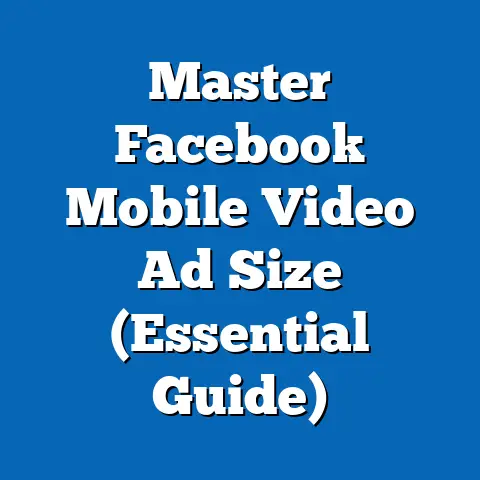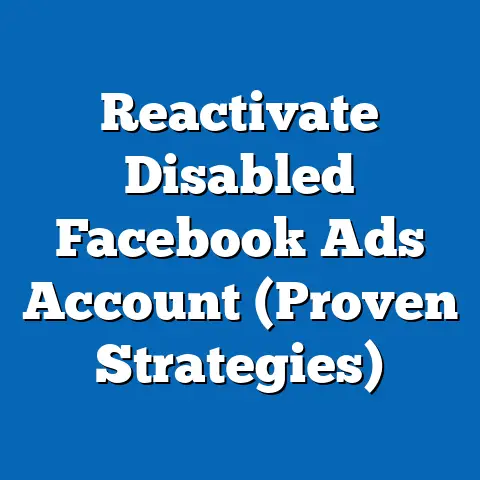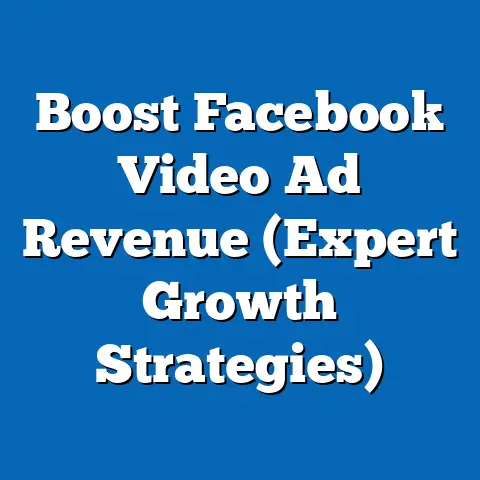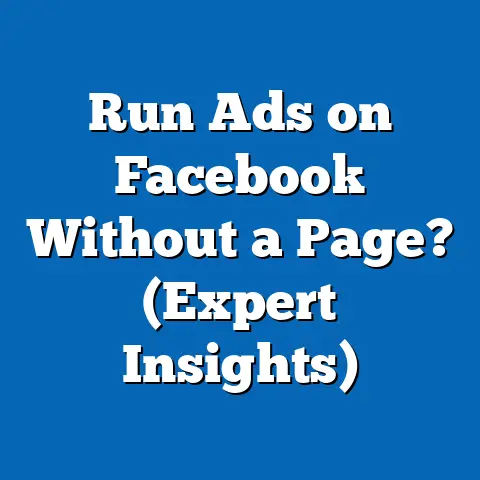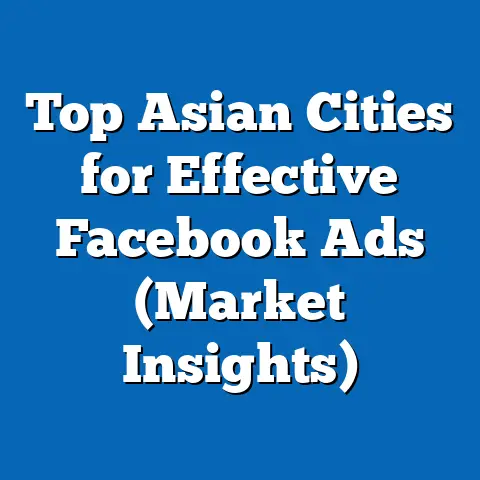Boost Reach: Connect Instagram Ads to Facebook (Smart Strategy)
In today’s hyper-connected world, if your business isn’t actively engaging on social media, you’re essentially invisible to a massive segment of your potential customer base. Social media is no longer just a place for sharing vacation photos; it’s a battleground where brands fight for attention, brand loyalty, and ultimately, sales. The truth is, the digital marketing landscape is fiercely competitive, and standing out from the crowd requires a strategic approach.
I remember when I first started managing social media for a small business – I was overwhelmed by the sheer volume of content being pumped out every single day. It felt impossible to get our message heard. That’s when I realized the power of integrated campaigns and the potential of connecting Instagram ads to Facebook. It’s a game-changer!
Consider these statistics: Instagram, a visual powerhouse, boasts over one billion active users. Facebook, the reigning king of social media, continues to dominate the global landscape. By not leveraging the combined power of these platforms, you’re not just missing out – you’re actively hindering your business’s growth potential. Failing to connect your Instagram ads to Facebook is like trying to run a marathon with one leg tied. Why limit yourself when you can double your reach, refine your targeting, and streamline your ad management? The time to act is now, before your competitors seize the opportunity and leave you playing catch-up.
Understanding the Power of Integration
Think of Facebook and Instagram as two sides of the same coin. They’re both owned by Meta, which means they share a sophisticated infrastructure that allows for seamless integration. When you connect your Instagram ads to Facebook, you unlock a powerful synergy that amplifies your marketing efforts.
Here’s what you gain:
-
Streamlined Ad Management: No more juggling multiple platforms and dashboards. With Facebook Ads Manager, you can create, manage, and monitor your campaigns for both Instagram and Facebook from a single, centralized location. This saves you time, reduces the risk of errors, and allows you to focus on strategy and optimization.
-
Shared Audience Insights: Connecting your accounts gives you a holistic view of your audience across both platforms. You can see which demographics, interests, and behaviors are most common among your followers and customers, allowing you to create more targeted and effective ad campaigns. I’ve found that this shared data is invaluable for understanding the nuances of my target audience.
-
Enhanced Targeting Options: The integration unlocks advanced targeting options that wouldn’t be available if you were running separate campaigns. You can leverage Facebook’s powerful targeting capabilities to reach your ideal customers on Instagram, ensuring that your ads are seen by the people who are most likely to be interested in your products or services.
-
Cohesive Campaigns: Connecting your Instagram and Facebook ads allows you to create cohesive campaigns that resonate across both platforms. You can use the same messaging, visuals, and branding to create a consistent brand experience for your audience, regardless of where they encounter your ads.
Streamlined Ad Management: No more juggling multiple platforms and dashboards. With Facebook Ads Manager, you can create, manage, and monitor your campaigns for both Instagram and Facebook from a single, centralized location. This saves you time, reduces the risk of errors, and allows you to focus on strategy and optimization.
Shared Audience Insights: Connecting your accounts gives you a holistic view of your audience across both platforms. You can see which demographics, interests, and behaviors are most common among your followers and customers, allowing you to create more targeted and effective ad campaigns. I’ve found that this shared data is invaluable for understanding the nuances of my target audience.
Enhanced Targeting Options: The integration unlocks advanced targeting options that wouldn’t be available if you were running separate campaigns. You can leverage Facebook’s powerful targeting capabilities to reach your ideal customers on Instagram, ensuring that your ads are seen by the people who are most likely to be interested in your products or services.
Cohesive Campaigns: Connecting your Instagram and Facebook ads allows you to create cohesive campaigns that resonate across both platforms. You can use the same messaging, visuals, and branding to create a consistent brand experience for your audience, regardless of where they encounter your ads.
Real-World Example:
Consider a clothing brand that wants to promote its new summer collection. By connecting their Instagram and Facebook ads, they can create a campaign that targets fashion-conscious individuals on both platforms. They can use visually appealing images and videos of their new collection on Instagram, while also leveraging Facebook’s detailed targeting options to reach specific demographics, interests, and behaviors. This integrated approach ensures that their message reaches the right people, at the right time, and in the right place.
I’ve personally seen this strategy work wonders. One of my clients, a local coffee shop, saw a 30% increase in website traffic and a 20% increase in online orders after connecting their Instagram and Facebook ads. The key was creating a cohesive campaign that showcased their unique coffee blends and inviting atmosphere on both platforms.
Takeaway: Connecting your Instagram ads to Facebook provides a powerful synergy that streamlines ad management, enhances targeting, and allows for cohesive campaigns across both platforms.
Setting Up Your Ads for Success
Now that you understand the benefits of connecting your Instagram ads to Facebook, let’s dive into the step-by-step process of setting up your ads for success. Don’t worry, it’s not as complicated as it sounds!
-
Link Your Accounts: The first step is to link your Instagram business account to your Facebook page. To do this, go to your Facebook page settings, click on “Instagram,” and follow the instructions to connect your account. Make sure you have admin access to both your Facebook page and Instagram business account.
-
Create a Campaign in Facebook Ads Manager: Once your accounts are linked, head over to Facebook Ads Manager. Click on the “Create” button to start a new campaign.
-
Choose Your Campaign Objective: Facebook offers a variety of campaign objectives, such as awareness, traffic, engagement, leads, and sales. Choose the objective that best aligns with your marketing goals. For example, if you want to drive traffic to your website, select the “Traffic” objective. If you want to generate leads, select the “Leads” objective.
-
Define Your Audience: This is where the magic happens! Use Facebook’s detailed targeting options to define your ideal audience based on demographics, interests, behaviors, and custom audiences. You can also create lookalike audiences to reach new customers who are similar to your existing ones.
-
Choose Your Ad Placements: In the “Placements” section, select “Automatic Placements” to let Facebook optimize your ad delivery across both Instagram and Facebook. Alternatively, you can choose “Manual Placements” to select specific placements, such as Instagram Feed, Instagram Stories, Facebook Feed, and Facebook Marketplace.
-
Set Your Budget and Schedule: Determine your daily or lifetime budget and set the start and end dates for your campaign.
-
Create Your Ads: Now it’s time to create your ad creatives. Choose the right ad formats for both platforms, such as image ads, video ads, carousel ads, and collection ads.
-
Instagram Stories Ads: These are full-screen, immersive ads that appear between users’ stories. They’re perfect for capturing attention and driving engagement.
-
Instagram Feed Ads: These ads appear in users’ Instagram feeds, just like organic posts. They’re great for showcasing your products or services and driving traffic to your website.
-
Facebook Feed Ads: Similar to Instagram Feed ads, these ads appear in users’ Facebook feeds. They’re ideal for reaching a wider audience and driving brand awareness.
-
-
Tailor Your Content: While maintaining brand consistency, it’s important to tailor your content to suit the unique characteristics of each platform. Instagram is a visual platform, so focus on high-quality images and videos. Facebook is more text-based, so use compelling copy to capture attention.
Link Your Accounts: The first step is to link your Instagram business account to your Facebook page. To do this, go to your Facebook page settings, click on “Instagram,” and follow the instructions to connect your account. Make sure you have admin access to both your Facebook page and Instagram business account.
Create a Campaign in Facebook Ads Manager: Once your accounts are linked, head over to Facebook Ads Manager. Click on the “Create” button to start a new campaign.
Choose Your Campaign Objective: Facebook offers a variety of campaign objectives, such as awareness, traffic, engagement, leads, and sales. Choose the objective that best aligns with your marketing goals. For example, if you want to drive traffic to your website, select the “Traffic” objective. If you want to generate leads, select the “Leads” objective.
Define Your Audience: This is where the magic happens! Use Facebook’s detailed targeting options to define your ideal audience based on demographics, interests, behaviors, and custom audiences. You can also create lookalike audiences to reach new customers who are similar to your existing ones.
Choose Your Ad Placements: In the “Placements” section, select “Automatic Placements” to let Facebook optimize your ad delivery across both Instagram and Facebook. Alternatively, you can choose “Manual Placements” to select specific placements, such as Instagram Feed, Instagram Stories, Facebook Feed, and Facebook Marketplace.
Set Your Budget and Schedule: Determine your daily or lifetime budget and set the start and end dates for your campaign.
Create Your Ads: Now it’s time to create your ad creatives. Choose the right ad formats for both platforms, such as image ads, video ads, carousel ads, and collection ads.
-
Instagram Stories Ads: These are full-screen, immersive ads that appear between users’ stories. They’re perfect for capturing attention and driving engagement.
-
Instagram Feed Ads: These ads appear in users’ Instagram feeds, just like organic posts. They’re great for showcasing your products or services and driving traffic to your website.
-
Facebook Feed Ads: Similar to Instagram Feed ads, these ads appear in users’ Facebook feeds. They’re ideal for reaching a wider audience and driving brand awareness.
Instagram Stories Ads: These are full-screen, immersive ads that appear between users’ stories. They’re perfect for capturing attention and driving engagement.
Instagram Feed Ads: These ads appear in users’ Instagram feeds, just like organic posts. They’re great for showcasing your products or services and driving traffic to your website.
Facebook Feed Ads: Similar to Instagram Feed ads, these ads appear in users’ Facebook feeds. They’re ideal for reaching a wider audience and driving brand awareness.
Tailor Your Content: While maintaining brand consistency, it’s important to tailor your content to suit the unique characteristics of each platform. Instagram is a visual platform, so focus on high-quality images and videos. Facebook is more text-based, so use compelling copy to capture attention.
I’ve learned that A/B testing different ad creatives is crucial for optimizing performance. Try testing different headlines, images, and call-to-actions to see what resonates best with your audience on each platform.
Takeaway: Setting up your ads for success involves linking your accounts, creating a campaign in Facebook Ads Manager, choosing the right objective, defining your audience, selecting your ad placements, setting your budget and schedule, and creating tailored ad creatives for both Instagram and Facebook.
Targeting the Right Audience
Targeting is the cornerstone of any successful advertising campaign. Without a well-defined target audience, your ads are like a ship without a rudder – they’ll drift aimlessly and ultimately fail to reach their destination. Fortunately, connecting your Instagram and Facebook ads unlocks a wealth of advanced targeting capabilities that can help you reach the right people, at the right time, and with the right message.
Here’s a breakdown of the key targeting options:
-
Demographics: Target your audience based on age, gender, location, education, job title, and other demographic factors.
-
Interests: Reach people who have expressed an interest in specific topics, hobbies, or activities. Facebook gathers this information based on users’ likes, shares, comments, and other online activities.
-
Behaviors: Target your audience based on their online behavior, such as purchase history, device usage, and travel habits.
-
Custom Audiences: Create custom audiences by uploading a list of your existing customers’ email addresses or phone numbers. You can then use these custom audiences to target your ads to your existing customers or to create lookalike audiences.
-
Lookalike Audiences: Expand your reach by creating lookalike audiences based on your existing customers or website visitors. Facebook will identify people who share similar characteristics and behaviors as your existing audience, allowing you to reach new customers who are likely to be interested in your products or services.
Demographics: Target your audience based on age, gender, location, education, job title, and other demographic factors.
Interests: Reach people who have expressed an interest in specific topics, hobbies, or activities. Facebook gathers this information based on users’ likes, shares, comments, and other online activities.
Behaviors: Target your audience based on their online behavior, such as purchase history, device usage, and travel habits.
Custom Audiences: Create custom audiences by uploading a list of your existing customers’ email addresses or phone numbers. You can then use these custom audiences to target your ads to your existing customers or to create lookalike audiences.
Lookalike Audiences: Expand your reach by creating lookalike audiences based on your existing customers or website visitors. Facebook will identify people who share similar characteristics and behaviors as your existing audience, allowing you to reach new customers who are likely to be interested in your products or services.
Leveraging Facebook’s Audience Insights:
Facebook’s Audience Insights tool provides valuable data about your target audience, including their demographics, interests, behaviors, and online activities. Use this tool to gain a deeper understanding of your audience’s preferences and tailor your ad campaigns accordingly.
Example:
Let’s say you’re a fitness studio that wants to promote its new yoga classes. You can use Facebook’s targeting options to reach people who are interested in yoga, fitness, and wellness. You can also target people who live near your studio and who have previously visited your website. By combining these targeting options, you can create a highly targeted ad campaign that reaches the people who are most likely to be interested in your yoga classes.
I’ve found that leveraging lookalike audiences is a particularly effective strategy for expanding reach. One of my clients, an online jewelry store, saw a 40% increase in sales after creating a lookalike audience based on their existing customers. The key was to use a high-quality customer list and to continuously refine the lookalike audience based on performance data.
Takeaway: Targeting the right audience is crucial for the success of your ad campaigns. Use Facebook’s advanced targeting options to reach your ideal customers based on demographics, interests, behaviors, custom audiences, and lookalike audiences.
Analyzing Performance and Making Adjustments
Your work isn’t done once your ads are live. In fact, that’s when the real work begins! Analyzing performance and making adjustments is crucial for optimizing your campaigns and maximizing your return on investment (ROI).
Here’s how to track and analyze your ad performance:
-
Facebook Analytics: Facebook Analytics provides a comprehensive view of your ad performance, including metrics such as reach, impressions, engagement, website traffic, and conversions. Use this tool to track the overall performance of your campaigns and identify areas for improvement.
-
Instagram Insights: Instagram Insights provides data about your audience, your content, and your ad performance. Use this tool to track metrics such as reach, impressions, engagement, and website clicks.
Facebook Analytics: Facebook Analytics provides a comprehensive view of your ad performance, including metrics such as reach, impressions, engagement, website traffic, and conversions. Use this tool to track the overall performance of your campaigns and identify areas for improvement.
Instagram Insights: Instagram Insights provides data about your audience, your content, and your ad performance. Use this tool to track metrics such as reach, impressions, engagement, and website clicks.
Key Performance Indicators (KPIs):
Focus on the following KPIs to assess the effectiveness of your campaigns:
-
Reach: The number of unique people who saw your ads.
-
Impressions: The number of times your ads were displayed.
-
Engagement: The number of likes, comments, shares, and clicks your ads received.
-
Click-Through Rate (CTR): The percentage of people who clicked on your ads.
-
Conversion Rate: The percentage of people who completed a desired action, such as making a purchase or filling out a form.
-
Cost Per Acquisition (CPA): The cost of acquiring a new customer through your ad campaigns.
Reach: The number of unique people who saw your ads.
Impressions: The number of times your ads were displayed.
Engagement: The number of likes, comments, shares, and clicks your ads received.
Click-Through Rate (CTR): The percentage of people who clicked on your ads.
Conversion Rate: The percentage of people who completed a desired action, such as making a purchase or filling out a form.
Cost Per Acquisition (CPA): The cost of acquiring a new customer through your ad campaigns.
A/B Testing:
A/B testing is a powerful technique for optimizing your ad creatives and targeting strategies. Create multiple versions of your ads with different headlines, images, and call-to-actions. Then, run these ads simultaneously and track their performance to see which version performs best.
I always recommend A/B testing different targeting strategies as well. Try targeting different demographics, interests, and behaviors to see which segments respond best to your ads.
Making Adjustments:
Based on your performance data, make adjustments to your campaigns to improve their effectiveness. This might involve tweaking your ad creatives, refining your targeting, or adjusting your budget.
Example:
Let’s say you’re running an ad campaign to promote a new product. You notice that your CTR is low, but your conversion rate is high. This suggests that your ad creative is not compelling enough to grab people’s attention, but that your product is appealing once people click on your ad. In this case, you might want to try A/B testing different headlines and images to see if you can improve your CTR.
Takeaway: Analyzing performance and making adjustments is crucial for optimizing your ad campaigns and maximizing your ROI. Use Facebook Analytics and Instagram Insights to track your ad performance, focus on key performance indicators, and A/B test different ad creatives and targeting strategies.
Conclusion
The social media landscape is dynamic and ever-changing. Connecting your Instagram ads to Facebook is no longer just a “nice-to-have” – it’s a necessity for businesses that want to thrive in this competitive environment. By integrating your campaigns, you can streamline your ad management, enhance your targeting, and create cohesive brand experiences that resonate with your audience.
Don’t wait another day to unlock the full potential of your social media advertising efforts. Take immediate steps to connect your Instagram ads to Facebook and start reaping the rewards. The time to act is now! Those who delay may miss out on the potential growth and engagement that an integrated advertising strategy can bring. Seize the opportunity and watch your business soar!

